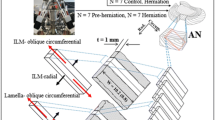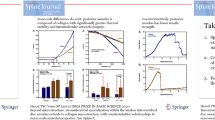Abstract
Purpose
To determine the effect of age on the biomechanical properties of the intralamellar matrix of single annulus fibrosus (AF) lamellae.
Methods
One intervertebral disc (IVD) was excised from five young (<12 months), five middle-aged (2–4 years) and five older (5–7 years) ovine lumbar spines. From each IVD, a maximum of four single AF lamellae samples were harvested: two from the anterior region and two from the posterior region. Tissues were mounted in a tensile testing apparatus such that tension was applied perpendicular to the orientation of the collagen fibers to isolate the intralamellar matrix. Variables of interest from the stress–strain relationship were: end of toe-region strain and corresponding stress, initial failure stress and strain, and elastic stiffness.
Results
When compared to the middle-aged and old samples, the intralamellar matrix of young AF samples displayed significantly higher stress values at the end of the end of toe-region (p = 0.008) and at initial failure (p = 0.002). Further, the young samples were stiffer than both middle-aged and old samples (p = 0.04).
Conclusions
This study was the first to show that the intralamellar matrix of single AF lamellae is weaker and more compliant in middle-aged and old ovine IVDs compared to young IVDs. These findings are likely a result of the remarkable age-related changes that occur that ultimately weaken the IVD as a whole.







Similar content being viewed by others
References
Marchand F, Ahmed AM (1990) Investigation of the laminate structure of lumbar disc anulus fibrosus. Spine 15:110–402
Aguiar DJ, Johnson SL, Oegema TR (1999) Notochordal cells interact with nucleus pulposus cells: regulation of proteoglycan synthesis. Exp Cell Res 246:129–137
Gower WE, Pedrini V (1969) Age-related variations in protein polysaccharides from human nucleus and costal cartilage. J Bone Joint Surg 51:1154–1162
Kandel R, Hamilton D, Séguin C et al (2007) An in vitro tissue model to study the effect of age on nucleus pulposus cells. Eur Spine J 16:2166–2173
Reid JE, Meakin JR, Robins SP et al (2002) Sheep lumbar intervertebral discs as models for human discs. Clin Biomech 17:312–314
Antoniou J, Steffen T, Nelson F et al (1996) The human lumbar intervertebral disc: evidence for changes in the biosynthesis and denaturation of the extracellular matrix with growth, maturation, ageing and degeneration. J Clin Invest 98:996–1003
Adams MA, Nally D, Dolan P (1996) ‘Stress’ distributions inside intervertebral discs the effects of age and degeneration. J Bone Joint Surg 78:965–972
Roughley PJ (2004) Biology of intervertebral disc aging and degeneration: involvement of the extracellular matrix. Spine 29:2691–2699
Zhao C-Q, Wang L-M, Jiang L-S, Dai L-Y (2007) The cell biology of intervertebral disc aging and degeneration. Ageing Res Rev 6:247–261
Holzapfel G, Schulze-Bauer CJ, Feigl G et al (2005) Single lamellar mechanics of the human lumbar anulus fibrosus. Biomech Model Mechanobiol 3:125–140
Skaggs DL, Weidenbaum M, Iatridis JC et al (1994) Regional variation in tensile properties and biochemical composition of the human lumbar anulus fibrosus. Spine 19:1310–1319
Tampier C, Drake JD, Callaghan JP, McGill SM (2007) Progressive disc herniation: an investigation of the mechanism using radiologic, histochemical, and microscopic dissection techniques on a porcine model. Spine 32(25):2869–2874
Wilke HJ, Kettler A, Wenger KH et al (1997) Anatomy of the sheep spine and its comparison to the human spine. Anat Rec 247:542–555
O’Connell GD, Vresilovic EJ, Elliott DM (2007) Comparison of animals used in disc research to human lumbar disc geometry. Spine 32:328–333
Showalter BL, Beckstein J, Martin J et al (2012) Comparison of animal discs used in disc research to human lumbar disc. Spine 37:E900–E907
Schmidt H, Reitmaier S (2013) Is the ovine intervertebral disc a small human one? A finite element model study. J Mech Behav Biomed Mater 17:229–241
Reutlinger C, Burki A, Brandejsk V et al (2014) Specimen specific parameter identification of ovine lumbar intervertebral discs: On the influence of fibre matrix and fibre–fibre shear interactions. J Mech Behav Biomed Mater 30:279–289
Karakaşli A, Yıldız DV, Kumtepe E et al (2013) Biomechanical comparison of intact lumbar lamb spine and endoscopic discectomized lamb spine. Eklem Hastalik Cerrahisi 24:33–38
Hollingsworth NT, Wagner DR (2012) The stress and strain states of the posterior annulus under flexion. Spine 37:E1134–E1139
Gregory DE, Callaghan JP (2011) Does vibration influence the initiation of intervertebral disc herniation? an example of herniation occurrence using a porcine cervical disc model. Spine 36:E225–E231
Iatridis JC, MaClean JJ, Ryan D (2005) Mechanical damage to the intervertebral disc annulus fibrosus subjected to tensile loading. J Biomech 38:557–565
Gunning JL, Callaghan JP, Mcgill SM (2001) Spinal posture and prior loading history modulate compressive strength and type of failure in the spine : a biomechanical study using a porcine cervical spine model. Clin Biomech 16:471–480
Costi JJ, Hearn TC, Fazzalari NL (2002) The effect of hydration on the stiffness of intervertebral discs in an ovine model. Clin Biomech 17:446–455
Ebara S, Iatridis JC, Setton LA et al (1996) Tensile properties of the non-degenerate human lumbar annulus fibrosus. Spine 21:452–461
Pezowicz CA, Robertson PA, Broom ND (2005) Intralamellar relationships within the collagenous architecture of the annulus fibrosus imaged in its fully hydrated state. J Anat 207:299–312
Dolan P, Luo J, Pollintine P et al (2013) Intervertebral disc decompression following endplate damage: implications for disc degeneration depend on spinal level and age. Spine 38:1473–1481
Park C, Kim YJ, Lee CS et al (2005) An in vitro animal study of the biomechanical responses of anulus fibrosus with aging. Spine 30:E259–E265
Beckstein JC, Sen S, Schaer TP et al (2008) Comparison of animal discs used in disc research to human lumbar disc: axial compression mechanics and glycosaminoglycan content. Spine 33:E166–E173
Trout JJ, Buckwaltert JA, Moore KC et al (1982) Ultrastructure of the human intervertebral disc. I. changes in notochordal cells with age. Tissue Cell 14:359–369
Pazzaglia UE, Salisbury JR (1989) Development and involution of the notochord in the human spine. J R Soc Med 82:413–415
Weiler C, Nerlich AG, Schaaf R, Bachmeier BE, Wuertz K, Boos N (2010) Immunohistochemical identification of notochordal markers in cells in the aging human lumbar intervertebral disc. Eur Spine J 19:1761–1770
Sun Z, Wang HQ, Liu ZH, Chang L, Chen YF, Zhang YZ, Zhang WL, Gao Y, Wan ZY, Che L, Liu X, Samartzis D, Luo ZJ (2013) Down-regulated CK8 expression in human intervertebral disc degeneration. Int J Med Sci 10:948–956
Melrose J, Smith SM, Appleyard RC, Little CB (2008) Aggrecan, versican and type VI collagen are components of annular translamellar crossbridges in the intervertebral disc. Eur Spine J 17:314–324
Olczyk K (1994) Age-related changes of elastin content in human intervertebral discs. Folia Histochem Cytobiol 32:41–44
Smith LJ, Fazzalari NL (2006) Regional variations in the density and arrangement of elastic fibres in the anulus fibrosus of the human lumbar disc. J Anat 209:359–367
Cloyd JM, Elliott DM (2007) Elastin content correlates with human disc degeneration in the anulus fibrosus and nucleus pulposus. Spine 32:1826–1831
Smith LJ, Fazzalari NL (2009) The elastic fibre network of the human lumbar anulus fibrosus: architecture, mechanical function and potential role in the progression of intervertebral disc degeneration. Euro Spine J 18:439–448
Aufdermaur M (1974) Spinal injuries in juveniles: necropsy findings in twelve cases. J Bone Surg 56B:513–519
Karlsson L, Lundin O, Ekstrom L et al (1974) Injuries in adolescent spine exposed to compressive loads: an experimental cadaveric study. J Spinal Disord 11:501–507
Schollum ML, Robertson P, Broom ND (2007) How age influences unravelling morphology of annular lamellae—a study of interfibre cohesivity in the lumbar disc. J Anat 216:310–319
Guerin HAL, Elliott DM (2006) Degeneration affects the fiber reorientation of human annulus fibrosus under tensile load. J Biomech 39:1410–1418
Acknowledgments
The authors wish to thank The Natural Sciences and Engineering Research Council of Canada (NSERC) for financial support.
Author information
Authors and Affiliations
Corresponding author
Ethics declarations
Conflict of interest
The authors of this paper declare that there are no conflict of interest.
Rights and permissions
About this article
Cite this article
Stewart, D.M., Monaco, L.A. & Gregory, D.E. The aging disc: using an ovine model to examine age-related differences in the biomechanical properties of the intralamellar matrix of single lamellae. Eur Spine J 26, 259–266 (2017). https://doi.org/10.1007/s00586-016-4603-4
Received:
Revised:
Accepted:
Published:
Issue Date:
DOI: https://doi.org/10.1007/s00586-016-4603-4




